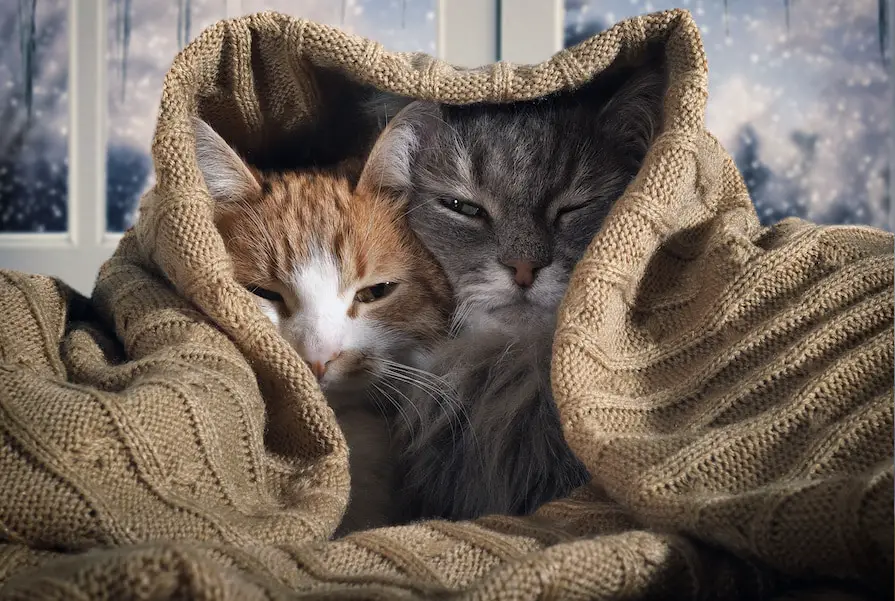By Chelsy Ranard
My cat has had her fair share of interesting experiences. She’s lived with kittens, cats, dogs, roommates, and even a snake at one point. She’s flown out of state with me while I worked seasonally, and driven with me just as far. Her current experience is one where I bring foster kittens home every few months while they grow and learn.
Her upcoming experience is one she’s not aware of yet, where we are bringing a new feline family member home to be her forever sister — not just as a temporary foster. Despite her experiencing new situations, people, and animals her whole life, she’s not great at meeting new animals. Needless to say, I’ve had my fair share of introducing new cats into my home with an unwelcoming host.
Each household has its own unique way of running. For that reason, there isn’t an exact science to introducing a new cat to your cats. Cats have different temperaments, so it can be hard to be sure you’re creating a positive introduction. However, cats are also very instinctual. For that reason, there are things you can do to help the process run as smoothly as possible. A successful introduction is all about adopting a feline with personality traits that will mesh with your other cats. You’ll need to understanding each pet’s situation, prepare for special cases, and get used to the new normal.
Adopting the Right Furry Family Member for your Home
We don’t always get to choose the new cat that we welcome into our families. When you adopt the stray that winds up on your porch, or you adopt one from a family member or friend, many times you get the cat you get. You provide it a home because it needs one. However, if you adopt a cat in a shelter setting, you can avoid a lot of personality clashes by scoping out the right temperament fit for your home.
For instance, if the cats you currently have enjoy playing, you might want to get a playful cat. If your cats enjoys sleeping, you may want to find a more mellow or older cat. Personality matches can help them live cohesively.
Remember, it’s not just about finding the right fit for your other cats; it’s also about finding the right one for you, your family, and your lifestyle too. If you have kids, other pets, or you travel a lot, you’ll want to find a cat who is okay with those things. Doing that homework first can make an introduction a lot easier on you, your cats, and your new family member. In addition to finding the right personality, be sure you’re bringing a cat home that has all of its vaccinations. Likewise be sure your current pets’ vaccinations are up-to-date as well.

Managing Your New Cat
When introducing your new cat to your home, it’s important to think about how they must be feeling. Many cats don’t like change, and being adopted into a new home is scary for them. They don’t know you, the new environment, nor do they know the other people or animals in your home. For that reason, it’s important to give your new cat plenty of time to feel safe. Just as you would take precautions when moving your current pets to a new home, your new cat will require many of the same precautions. Allow them to have an area to themselves for a while – preferably a cozy bedroom or office space. Provide them with somewhere to hide, a bed, food, water and a litter box. Consider using pheromone products like Feliway MultiCat to help ease tensions for your new kitty and for your current ones.
Slowly introduce your current cat’s scent to the new cat by placing a rag you’ve rubbed on your current cat and placing it near the new cat’s food. This will help your new cat to associate your current cat’s smells with something positive, like eating. Do the same for your pets and your newcomer’s scent. Don’t be afraid to follow their lead. Some may feel at home faster than others. If your new cat and your other cats initiate a meeting without incident, feel free to allow them to do so. If you have a dog, take care in introducing your new cat to your dog as well.
Managing Your Current Cats
Your current cats don’t like change either, and a newcomer may feel like as if they’re trespassing on their territory. For this reason, it’s also great for your current cats to give your new one a place to settle and feel safe. Felines can sometimes use aggression, marking, or destructive behavior as a response to a new animal. To help ease these responses, allow each animal to take their time. Integrate their scent slowly and allow them to be upset if they feel that way. Some smelling and hissing is to be expected. If you see more aggressive behavior, like flattened ears or crouching, distract them with a loud noise (like a rattle) or herd them away from each other until they can try again.
For cats who are the “only child,” they may have a harder time with the introduction due to a lack of experience in this area. Be prepared for that meeting to take longer. If your current cats are becoming more aggressive, feel free to reach out to your shelter, vet, or cat behaviorist to help you with more tactics to help your cats live cohesively.
Preparing for Special Cases
If you’re introducing a cat that is a special case, be prepared to take precautions in their meeting. Special cases can mean adopting a semi-feral cat, a cat who has been declawed, an undersocialized cat, or a cat with special needs. Though these special cases may require a more watchful eye during introductions, there can still be a happy meeting at the end of the process. In fact, cats with a special circumstance are usually harder to adopt out, so adopting one is an amazing gesture and these cats tend to know and appreciate their adopter.
Feral, stray or undersocialized cats will need more time to adjust, so patience is a must. Keep a watchful eye because these types of cats can be more aggressive because they’ve had to get along in the wild. Don’t worry – even if they are more aggressive, it doesn’t mean they are a lost cause. They’ll just need more time, patience and careful monitoring to ensure everyone’s safety.
A declawed cat requires special care so that they don’t get in a fight where they can’t defend themselves — which is also why they shouldn’t be outside at all. A special needs cat with a disability or medical issue may require more time to get used to their new home, but as long as you’re prepared for their long-term care needs, they can be the perfect companion to your other cats. If you’re introducing a declawed cat to home where you cats have claws, you may want to consider trimming your current cat’s nails with cat nail clippers – for everyone’s safety.

Your New Normal
It’s best to be prepared for what your new normal will look like. For some multi-cat homes, the cats live in one dwelling cohesively, almost as slightly disdainful roommates. They may hiss at each other every now and again, but they never become bonded. That’s totally okay, and many cats are fine with this normal. Other cats meet and enjoy the company of another feline friend. They may groom each other and play, or at least sleep on the same couch near each other. That’s okay, too. No one’s normal is identical. Just remember you have resources to help if your cats are having a harder time adjusting to one another. A shelter, animal behaviorist, or vet can offer solutions to aggression or marking.
Introductions in my house are nearly identical each time. The new cat, or cats, are given their own space, my cat goes to investigate, hisses, and sulks away. In time her hisses become less frequent, and eventually she can handle being in the same vicinity as the others. If they seem aggressive, I remove them from each other. My cat will never be the best host, but it’s a part of our normal. Introducing cats to each other can be stressful for you and your current cat(s). It will take lots of love and patience. It may be frustrating, but a slow meeting is usually necessary to keep everyone safe and happy. At the end of the day, your cats will adapt and establish their own version of “normal.”
Have you introduced cats? What have you found to be helpful in making introductions? Please feel free to share your own experiences in the comments!
